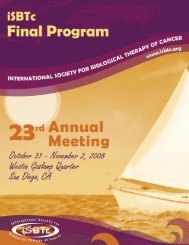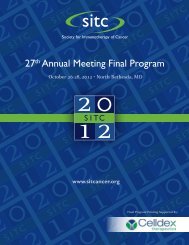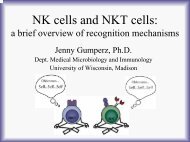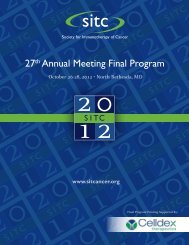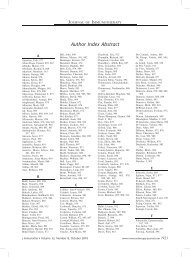Abstracts for the 25th Annual Scientific Meeting of the International ...
Abstracts for the 25th Annual Scientific Meeting of the International ...
Abstracts for the 25th Annual Scientific Meeting of the International ...
Create successful ePaper yourself
Turn your PDF publications into a flip-book with our unique Google optimized e-Paper software.
<strong>Abstracts</strong> J Immuno<strong>the</strong>r Volume 33, Number 8, October 2010<br />
did not change phosphorylation <strong>of</strong> MAPK, AKT, STAT3, STAT1<br />
or mTOR. Importantly, HGFab inhibited proliferation <strong>of</strong> PBMC<br />
to a similar degree as melanoma cells. These data suggest that<br />
HGFab has promise as anti-melanoma <strong>the</strong>rapy, but has potentially<br />
negative effects on immune cells. Our results indicate this may be<br />
mediated by different pathways than in melanoma cells. Differences<br />
in <strong>the</strong>se signaling pathways may be exploited by targeted <strong>the</strong>rapies<br />
and need to be defined be<strong>for</strong>e combining immune <strong>the</strong>rapy and anti-<br />
HGF <strong>the</strong>rapy.<br />
Molecular Basis <strong>of</strong> Aberrant Expression <strong>of</strong> Alkaline<br />
Phosphatase in Renal Brush Border Membrane from Renal<br />
Cell Carcinoma Patients<br />
Ujjawal Sharma*, Sarwan K. Singhw, Rajendra Prasad*. *Biochemistry;<br />
w Urology, PGIMER, Chandigarh, India.<br />
Background: The incidence <strong>of</strong> renal cell carcinoma (RCC) has been<br />
increasing worldwide. It continues to present a diagnostic and<br />
<strong>the</strong>rapeutic challenge. It accounts <strong>for</strong> approximately 3% <strong>of</strong> adult<br />
malignancies and 90% to 95% <strong>of</strong> neoplasm arising from kidney.<br />
RCC originates from proximal tubular epi<strong>the</strong>lium <strong>of</strong> adult kidney.<br />
Alkaline phosphatase is abundantly expressed on <strong>the</strong> BBM and<br />
serves as an excellent marker <strong>for</strong> its integrity. Earlier reports have<br />
demonstrated that <strong>the</strong> activities <strong>of</strong> brush border membrane (BBM)<br />
enzymes are altered in cancer cells. The present study was<br />
conducted to find out <strong>the</strong> molecular basis <strong>of</strong> altered expression/<br />
activity <strong>of</strong> ALP in BBM from RCC in comparison to normal<br />
renal BBM.<br />
Methods: Total 30 histopathologically confirmed cases <strong>of</strong> RCC<br />
were included in <strong>the</strong> present study. The activity <strong>of</strong> alkaline<br />
phosphatase was determined by enzymatic assay. The expression<br />
<strong>of</strong> alkaline phosphatase at protein level was determined by western<br />
blot and at expression level by RT PCR study.<br />
Results: The specific activity <strong>of</strong> ALP was drastically reduced in<br />
homogenate as well as in BBM from RCC as compared to BBM<br />
from adjacent normal kidney parenchyma.<br />
SDS-PAGE study showed that <strong>the</strong> BBM proteins <strong>of</strong> higher<br />
molecular weights were poorly expressed in BBM from RCC as<br />
compare to BBM from adjacent normal kidney parenchyma.<br />
Incubation <strong>of</strong> gel with BCIP/NBT dye showed that <strong>the</strong> expression<br />
<strong>of</strong> ALP in BBM from RCC was reduced as compared to adjacent<br />
normal kidney BBM. Western blot analysis using anti ALP<br />
antibody also confirmed <strong>the</strong> reduced expression <strong>of</strong> ALP in RCC<br />
BBM. Fur<strong>the</strong>r, to check whe<strong>the</strong>r this reduced expression <strong>of</strong> ALP<br />
occurs at mRNA level, a semi quantitative RT-PCR was done,<br />
which showed markedly reduced expression <strong>of</strong> ALP mRNA in<br />
RCC as compared to adjacent normal kidney.<br />
Conclusion: The reduced expression/activity <strong>of</strong> alkaline phosphatase<br />
in renal brush border membrane was due to reduced<br />
expression <strong>of</strong> alkaline phosphatase at transcriptional level.<br />
Overcoming BRAF Inhibitor Resistance in Melanoma<br />
Keiran Smalley*wz, Inna Fedorenkoz, Kim H. Paraisoz, Edward<br />
Flachw, Alexander R. Andersonw. *Cutaneous Oncology; w Integrated<br />
Ma<strong>the</strong>matical Oncology; zDepartment <strong>of</strong> Molecular Oncology,<br />
H. Lee M<strong>of</strong>fitt Cancer Center & Research Institute, Tampa, FL.<br />
The discovery that B50% <strong>of</strong> human melanomas harbor activating<br />
V600E mutations in <strong>the</strong> serine/threonine kinase BRAF has raised<br />
<strong>the</strong> possibility that <strong>the</strong>se tumors may be amenable to targeted<br />
<strong>the</strong>rapy. The importance <strong>of</strong> mutated BRAF <strong>for</strong> <strong>the</strong> growth and<br />
survival <strong>of</strong> melanoma cells has since been validated in a large<br />
number <strong>of</strong> pre-clinical studies and clinical trials <strong>of</strong> <strong>the</strong> novel BRAF<br />
kinase inhibitor PLX4032 are now underway. Initial results from<br />
<strong>the</strong> phase II extension trial <strong>of</strong> PLX4032 in melanoma patients<br />
selected <strong>for</strong> <strong>the</strong> BRAF V600E mutation are highly encouraging,<br />
with responses reported in an unprecedented 81% <strong>of</strong> those treated.<br />
Although <strong>the</strong> clinical development <strong>of</strong> BRAF inhibitors is at an<br />
early stage, it is already clear that <strong>the</strong> impressive levels <strong>of</strong> response<br />
seen initially do not necessarily persist <strong>for</strong> extended periods <strong>of</strong> time.<br />
Recent data from our group and o<strong>the</strong>rs suggests that melanoma<br />
cells re-wire <strong>the</strong>ir intracellular signaling when BRAF is inhibited<br />
and use parallel signal transduction pathways <strong>for</strong> <strong>the</strong>ir growth and<br />
progression. This presentation will discuss some <strong>of</strong> <strong>the</strong> putative<br />
mechanisms by which BRAF-mutated melanoma cells escape from<br />
BRAF inhibitor <strong>the</strong>rapy and will outline how <strong>the</strong>se contribute to<br />
both intrinsic and acquired resistance. It is expected that an<br />
enhanced understanding <strong>of</strong> <strong>the</strong> signaling cross-talk mechanisms<br />
present in melanoma cells will allow combination <strong>the</strong>rapy strategies<br />
to be designed which will ei<strong>the</strong>r delay or abrogate <strong>the</strong> onset <strong>of</strong><br />
resistance when BRAF is inhibited.<br />
Superior Killing Characteristics <strong>of</strong> a Tumor-Targeted,<br />
Genetically Encoded Trail Trimer (TR3)<br />
Dirk Spitzer*, Jesse Gibbs*, William G. Hawkins*w. *Department<br />
<strong>of</strong> Surgery, Washington University School <strong>of</strong> Medicine; w Siteman<br />
Cancer Center, Barnes Jewish Hospital and Washington University<br />
School <strong>of</strong> Medicine, St. Louis, MO.<br />
Background: Cancer cells <strong>of</strong>ten develop resistance to one or more<br />
apoptotic pathways. Recently it has been shown that even within a<br />
population <strong>of</strong> homogenous cancer cells, stochastic processes render<br />
some cells refractory to mono<strong>the</strong>rapy. As a result, it is believed that<br />
effective cancer <strong>the</strong>rapeutics cannot be mono<strong>the</strong>rapies but must be<br />
combined to overcome both evolved and stochastic resistance.<br />
TRAIL is an endogenous TNF-superfamily member that causes<br />
apoptosis via <strong>the</strong> extrinsic death receptor pathway. Un<strong>for</strong>tunately,<br />
TRAIL-mediated cell death is frequently incomplete even in <strong>the</strong><br />
presence <strong>of</strong> an increased cell surface density <strong>of</strong> <strong>the</strong>se receptors.<br />
Fortunately, cancer cells <strong>of</strong>ten express o<strong>the</strong>r, secondary tumor<br />
antigens on <strong>the</strong>ir surface, which are absent or much reduced on<br />
normal host cells and could be utilized to deliver TRAIL more<br />
specifically to <strong>the</strong> tumor microenvironment.<br />
Methods: We recently developed a novel TRAIL <strong>for</strong>m, designated<br />
TR3, which represents a fusion protein <strong>of</strong> three consecutive TRAIL<br />
ectodomains that is generically extensible with stoichiometric<br />
control. Besides its improved stability over non-covalently associated<br />
TRAIL trimers, we provide here an example <strong>of</strong> adding a<br />
single chain antibody (scFv) to <strong>the</strong> N-terminus <strong>of</strong> TR3 that<br />
specifically recognizes <strong>the</strong> tumor marker meso<strong>the</strong>lin, an antigen<br />
that is highly expressed in a number <strong>of</strong> human malignancies<br />
including pancreatic cancer. We generated two meso<strong>the</strong>lin targeted<br />
TR3 fusion proteins: one spacer containing (scFv-S-TR3) and one<br />
spacer-deficient (scFv-TR3) and assessed apoptosis induction<br />
following transient expression <strong>of</strong> meso<strong>the</strong>lin in cancer cell lines.<br />
Results: Non-targeted TR3 showed no bias toward meso<strong>the</strong>linexpressing<br />
target cells. In contrast, scFv-S-TR3 killed B25% more<br />
meso<strong>the</strong>lin-positive cells compared to non-transfected controls. As<br />
predicted, <strong>the</strong> spacer played a pivotal role in mediating <strong>the</strong><br />
improved killing capacity <strong>of</strong> scFv-S-TR3.<br />
Conclusions: We have generated a cancer-specific TRAIL <strong>for</strong>m that<br />
associates with surface-expressed meso<strong>the</strong>lin and, at <strong>the</strong> same time,<br />
facilitates engagement with surface-exposed death receptors. The<br />
spacer, introduced between <strong>the</strong> scFv and TR3 was absolutely<br />
required <strong>for</strong> this augmented killing effect. The ability to simultaneously<br />
bind a cancer drug selectively to a tumor antigen and<br />
induce stronger (or more sustained) signaling events that lead to<br />
superior target cell death raises <strong>the</strong> possibility <strong>of</strong> using tumortargeted<br />
TR3 as a mono<strong>the</strong>rapy.This work was supported by NIH<br />
grants 5P30CA9184208 and 1R21CA150945.<br />
Spontaneous Cytotoxic T cell Reactivity Against IDO Exists<br />
in Cancer Patients and in Healthy Donors<br />
Rikke B. Sørensen, Per T. Straten, Mads H. Andersen. Center <strong>for</strong><br />
Cancer Immune Therapy (CCIT), University Hospital Herlev,<br />
Herlev, Denmark.<br />
Indoleamine 2,3-dioxygenase (IDO) is an immunoregulatory<br />
enzyme that is implicated in suppressing T cell immunity in normal<br />
and pathological settings, including cancer. IDO regulates immune<br />
910 | www.immuno<strong>the</strong>rapy-journal.com r 2010 Lippincott Williams & Wilkins



